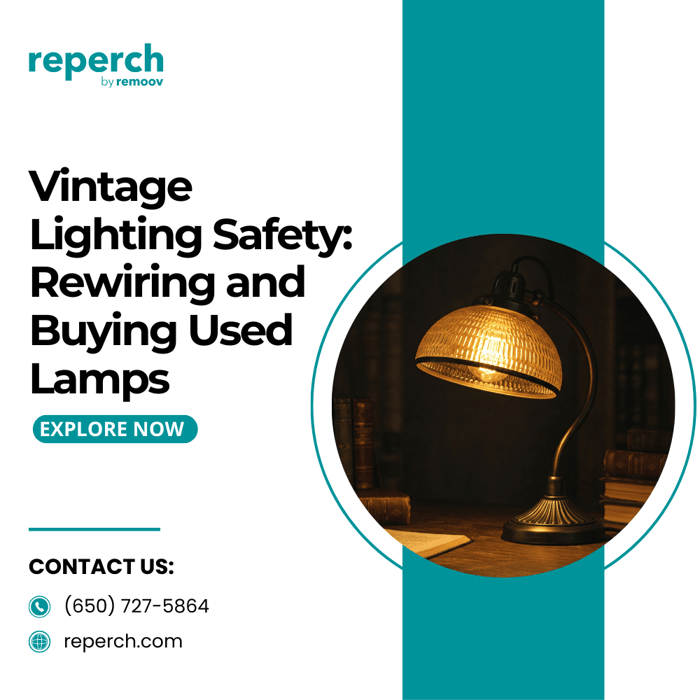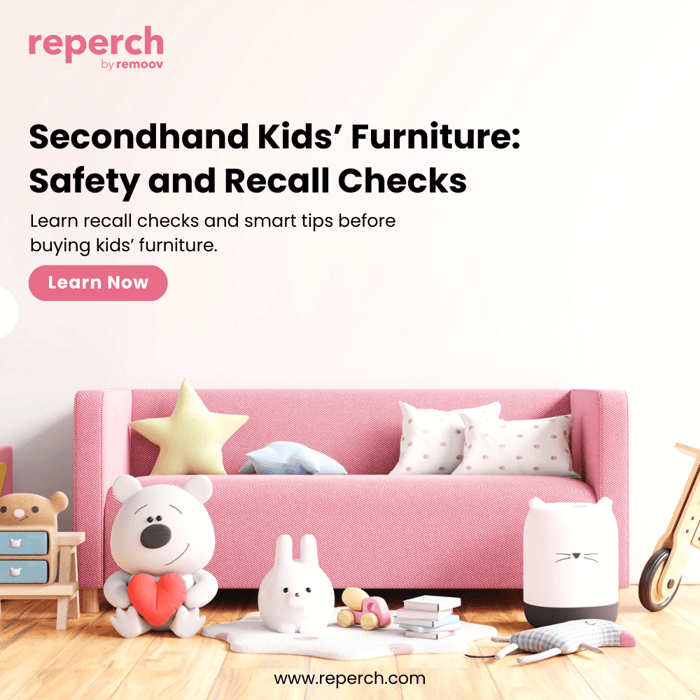Shopping secondhand for furniture is exciting, but few items bring the charm of vintage lamps. A retro ceramic base or mid-century floor lamp can light up a space literally and stylistically. But buying a vintage or thrifted light fixture comes with one major caveat: safety.
Before you fall in love with a sculptural lamp in a local antique store or thrift market, it’s important to assess its electrical health. Here's what to check, how to safely bring old lighting into your home, and when to seek professional rewiring help.
Why Vintage Lamps Are Popular Again
Vintage lighting combines craftsmanship, character, and sustainability. Compared to mass-produced modern options, secondhand fixtures often feature:
Unique, hand-crafted details
Durable materials like solid brass or ceramic
Styles that span decades Art Deco, Mid-Century Modern, Hollywood Regency
Eco-friendliness (less manufacturing waste, more reuse)
For many Reperch shoppers, lamps are an easy way to personalize a space without committing to large-scale furniture changes. But while that 1960s sconce or 1980s floor lamp may look great, you’ll want to check what’s going on behind the switch.
The Hidden Electrical Risks of Vintage Lighting
Unlike a used chair or cabinet, lamps are electric appliances. And with old wiring, that can mean serious fire and shock hazards.
According to the National Fire Protection Association (NFPA), electrical lighting and distribution systems are a top cause of home structure fires. Vintage lamps often come with:
Frayed or brittle cords
Two-prong, ungrounded plugs
Switches or sockets no longer up to code
Cloth-covered wiring prone to wear
These issues aren’t always visible at first glance. That’s why every vintage lighting piece should be carefully inspected or rewired before use.
How to Inspect a Vintage Lamp Before Buying
When browsing at thrift shops, flea markets, estate sales, or even online marketplaces, keep this checklist handy:
1. Test if the Lamp Works
Ask to plug the lamp into a nearby outlet. If it doesn’t turn on, ask for a discount or walk away unless you're ready for a repair project.
2. Examine the Cord
Run the cord through your fingers from the base to the plug. Look for:
Cracks
Fraying
Kinks
Exposed wires
If the insulation feels brittle or the plug is loose, it’s not safe to use without repairs.
3. Check for Stability
Wiggle the lamp at the neck. Does it feel wobbly or unstable? Check the base for cracks or chips. A top-heavy lamp on a weak base is a tipping hazard.
4. Inspect the Socket and Switch
Look inside the bulb socket. Is there corrosion or discoloration? Flip the switch; if it sticks or crackles, it may need replacement.
Should You Rewire It Yourself or Call a Pro?
If you love DIY projects and understand basic wiring, rewiring a lamp is a manageable job with a few tools and a new socket kit. But if you’re unsure about electrical safety, hiring a pro is worth the peace of mind.
Professional Rewiring: What to Expect
Electricians or lamp repair shops can:
Replace the cord with a UL-rated one
Install a grounded plug
Update the socket and switch
Ensure everything is up to current safety standards
Cost: $30–$75 depending on complexity. Considering the fire risk of faulty wiring, it’s a smart investment for a piece you’ll use daily.
Using Your Vintage Lamp Safely at Home
Even after a proper inspection or rewiring, take extra care when using old lamps.
1. Use the Right Bulb
Never exceed the wattage listed on the socket. Stick to energy-efficient LED bulbs, which produce less heat and last longer. Avoid halogen bulbs, which get extremely hot.
2. Avoid Flammable Surroundings
Don’t place lamps near curtains, bedding, or paper. Even with LED bulbs, it’s best to keep lamps at a safe distance from soft furnishings.
3. Mind the Cord
Never run cords under rugs or behind heavy furniture. This can cause pinching or abrasion, increasing the risk of short circuits.
4. Secure the Lamp
Make sure the lamp is on a sturdy, level surface, especially if you have pets or kids. For tall floor lamps, consider securing the base to prevent tipping.
Tips for Shopping Vintage Lamps on Reperch
Reperch features a variety of secondhand lighting options from boho rattan pendants to mid-century table lamps. Here’s how to shop smart:
Use filters to narrow by size, style, or shade type
Read seller notes about rewiring or condition
Message the seller to confirm functionality if not stated
Browse local listings for lamps you can inspect before buying
If you’re buying online and can’t test it in person, budget for professional rewiring just in case.
Final Thoughts: Style Meets Safety
A thrifted lamp can add vintage charm, color, and warmth to any room. But looks shouldn’t come at the cost of safety. Whether you’re shopping for your first retro fixture or adding to your growing collection, always inspect the wiring, prioritize function, and don’t hesitate to rewire.
By following these tips, you can enjoy your vintage lighting with confidence and light up your space in more ways than one.
Explore More Vintage Finds on Reperch
Ready to discover your next unique home upgrade? Browse our handpicked vintage lighting collection or explore stylish secondhand furniture that brings character and sustainability to your space.








